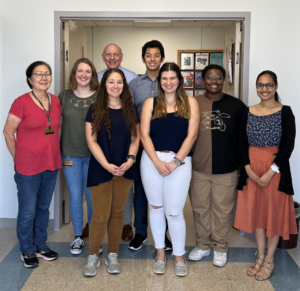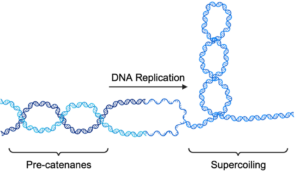

The plectonemic nature of DNA gives rise to a variety of topological problems as cellular machinery attempts to access the information stored in the genome. Transcription and replication open the double helix, causing significant DNA overwinding ahead of and underwinding behind the moving complexes. Additionally, recombination and replication create knots and tangles in DNA that must be removed in order for chromosomes to segregate properly. Topoisomerases are ubiquitous enzymes that modulate the topological structure of DNA to resolve these issues and maintain the integrity of the genome.

The Osheroff lab primarily focuses on type II topoisomerases, which carry out their activities by creating a transient double-stranded break in one segment of DNA and passing a second segment through the break. Because their catalytic cycle involves the creation of a DNA break, which is potentially dangerous for the cell, they are the targets for a number of anticancer and antibacterial drugs. Additionally, a number of natural products with chemopreventive properties display activity against these enzymes. Our lab is interested in characterizing interactions between these compounds and type II topoisomerases in order to design better agents to treat a variety of cancers and bacterial infections.
In addition to our studies on the interactions of drugs with type II topoisomerases, we are also interested in further investigating basic enzyme mechanisms with both human and bacterial topoisomerases. We still have much to learn about how the activities of these enzymes are influenced by DNA properties such as torsional and axial stress, supercoil geometry, and malleability, and we have developed a variety of tools and techniques to probe these issues.
BROAD RESEARCH AREAS
ENZYMOLOGY: The enzymatic mechanisms of human and bacterial type II topoisomerases.
We have defined individual steps in the catalytic cycle of the enzymes, developed novel model systems, and established conditions that allowed the structure of the covalent topoisomerase II-cleaved DNA complex to be determined.
ANTICANCER DRUGS AND CHEMOPREVENTIVE COMPOUNDS: The mechanism by which chemotherapeutic drugs and natural products act on human topoisomerase II.
This work has contributed greatly to our understanding of drug action, identified novel classes of anticancer agents and topoisomerase II-active agents, and shed light on the basis for altered drug sensitivity.
ANTIBACTERIAL DRUG RESISTANCE: Mechanisms of resistance to bacterial topoisomerase II-targeted compounds.
We have established that clinically relevant fluoroquinolones interact with their bacterial targets through a water-metal ion bridge and have used this knowledge to design both fluoroquinolone- and non-quinolone-based compounds that overcome drug resistance. Work with two new classes of compounds, the novel bacterial topoisomerase inhibitors (NBTIs) and spiropyrimidinetriones (SPTs), is currently underway.